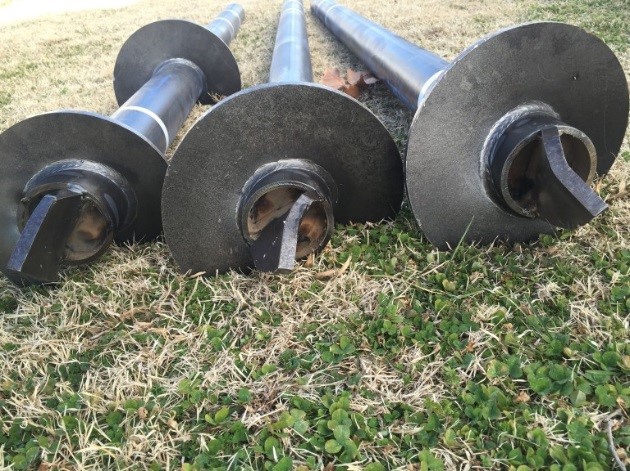Helical piles are deep foundation elements that look like, and are installed like, a large steel soil screw – they have a slender steel shaft with any number of round plates at the tip to provide support to the structure they hold. Helical piles are spun into the ground with a large torque motor and provide support through soil bearing on the plates and along the shaft. They come in many lengths and are often the foundation of choice for retrofitting existing buildings or new, urban construction, due to their small footprint and ability to create minimal disturbance to surrounding structures. Although helical piles are installed as foundation elements in seismically active areas such as New Zealand and Japan, they have not been used widely in seismically active areas of the United States. This lack of use is, admittedly, due to having no quantifiable data to illustrate the seismic behavior of helical piles. In addition, there are no side-by-side seismic comparisons to other deep foundation systems available, other than qualitative "survival" stories like those from the 2011 Christchurch earthquake.
After the series of earthquakes in 2011, the city of Christchurch was surveyed and it was found that all buildings/infrastructure constructed on helical piles sustained minimal structural damage, however, a large majority of the condemned buildings were constructed on other foundation types. The international community has qualitative proof that helical piles perform well in earthquake prone areas, but engineers have not quantified "why" those piles are superior foundation elements, and unfortunately, helical pile use in seismically active areas within the United States remains minimal. Therefore, this project seeks to find out "why" helical piles seem to behave so well in seismic regions by subjecting them to earthquake loads in the University of California - San Diego's Large Shake Table.
These data are especially important and timely to generate because certain areas of the United States are now requiring seismic retrofits of existing buildings, yet engineers have a dearth of data regarding foundation systems to help make these structures safer. For example, in October 2015, the City of Los Angeles voted on a seismic ordinance that will require more than 13,000 structures, both pre-stressed concrete and soft-story wood structures, to be seismically retrofitted. Even though it is known from qualitative studies (e.g., New Zealand and Japan) that piles with comparatively small cross-section and high anchoring capacity, such as helical piles, are beneficial for seismic resistance seemingly due to their slenderness, higher damping ratios, ductility, and resistance to tip uplift, building codes and current state of practice have not been adequately developed for this pile type because no quantitative data exist. Research of seismic behavior of helical pile supported structures is therefore imperative to generate necessary data that will help ensure that helical piles are being correctly applied in seismic areas and establish quantifiable benefits and/or limitations of helical pile use in seismic areas. This project will benefit people living in seismic zones by educating engineers with full-scale helical pile experimental data so that they better understand how to design a building system that is safer, more resilient and sustainable for individuals and the community.
This critical, and first of its kind, study will provide data on the kinematic and inertial behavior of full-scale single helical piles and evaluate the contribution of the helix to overall capacity. Same size slender shafts will be tested with varying helix geometry (e.g., double versus single), as well as installation method (spun versus driven). The piles will be heavily instrumented to measure bending moments, shear and load; all of which will be used to quantify helical pile behavior, validate future numerical modeling endeavors, as well as focus additional future full-scale experimental testing efforts. This study will also quantify behavior of helical piles in a group in both a pinned and fixed condition. The rocking behavior of these group piles will be analyzed to determine how much load is transferred down to the helix level and how it differs between piles in the same group, which affects stability. The study will also compare and contrast the behavior of a driven pile to a helical pile. The results of this study will provide data on the effectiveness of steel shaft slenderness on pile dynamics, the contribution of the helix to overall capacity and rocking behavior, as well as pile group fixity. These results will be of interest to the deep foundation industry, design engineers, government and private entities that utilize deep foundations for infrastructure projects in seismically active areas.

